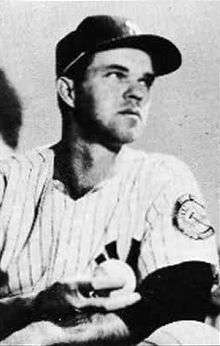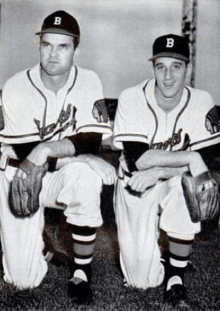Johnny Sain
John Franklin Sain (September 25, 1917 – November 7, 2006) was an American right-handed pitcher in Major League Baseball who was best known for teaming with left-hander Warren Spahn on the Boston Braves teams from 1946 to 1951. He was the runner-up for the National League's Most Valuable Player Award in the Braves' pennant-winning season of 1948, after leading the National League in wins, complete games and innings pitched. He later became further well known as one of the top pitching coaches in the majors.
| Johnny Sain | |||
|---|---|---|---|
 Sain in 1953 | |||
| Pitcher | |||
| Born: September 25, 1917 Havana, Arkansas | |||
| Died: November 7, 2006 (aged 89) Downers Grove, Illinois | |||
| |||
| MLB debut | |||
| April 17, 1942, for the Boston Braves | |||
| Last MLB appearance | |||
| July 15, 1955, for the Kansas City Athletics | |||
| MLB statistics | |||
| Win–loss record | 139–116 | ||
| Earned run average | 3.49 | ||
| Strikeouts | 910 | ||
| Teams | |||
| As player
As coach
| |||
| Career highlights and awards | |||
| |||
Military service
Beginning in late 1942, Sain served in the United States Navy during World War II.[1] As a navy pilot, he spent the next 3 years stateside while also playing baseball on the navy bases.[2] He was discharged in November 1945.[2]
Pitching star of post-war Boston Braves
Born in Havana, Arkansas, Sain pitched for 11 years, winning 139 games and losing 116 in his career and compiled an earned run average of 3.49. His best years were those immediately after World War II, when he won 100 games for the Boston Braves, before being traded to the New York Yankees during the 1951 season for Lew Burdette and cash.
Sain had the distinction of being the first pitcher in the Major Leagues to face Jackie Robinson. In 1943, while participating in a benefit game for the Red Cross, Sain became the last man to pitch against Babe Ruth in organized baseball.[3][4]
In 1948, Sain won 24 games against 15 losses and finished second in the voting for the Most Valuable Player Award behind the St. Louis Cardinals' Stan Musial, who had won two legs of the Triple Crown. Sain and teammate Spahn achieved joint immortality that year when their feats were the subject of sports editor Gerald V. Hern's poem in the Boston Post which was eventually shortened to the epigram "Spahn and Sain; then pray for rain." According to the Baseball Almanac, the original doggerel appeared in Hern's column on September 14, 1948:
First we'll use Spahn
then we'll use Sain
Then an off day
followed by rain
Back will come Spahn
followed by Sain
And followed
we hope
by two days of rain.

The poem was inspired by the performance of Sain and Spahn during the Braves' 1948 pennant drive. The team swept a Labor Day doubleheader, with Spahn throwing a complete game 14-inning win in the opener, and Sain pitching a shutout in the second game. Following two off days, it did rain. Spahn won the next day, and Sain won the day after that. Three days later, Spahn won again. Sain won the next day. After one more off day, the two pitchers were brought back, and won another doubleheader. The two pitchers had gone 8–0 in twelve days' time.[5]
That year, the Boston Braves won their second and last National League pennant of the post-1901 era, but fell in six games to the Cleveland Indians in the 1948 World Series. Sain won the first game of the Series, a 1–0 shutout at Braves Field that included a memorable play in which Boston catcher Phil Masi was called safe after an apparent pickoff at second base. Masi went on to score the game's only run.
With the Yankees, Sain became a relief pitcher and enjoyed late-career success, leading the American League in saves with 22 in 1954. He finished his career in 1955 with the Kansas City Athletics.
A very good hitting pitcher in his 11 year major league career, Sain posted a .245 batting average with 69 runs, 3 home runs and 101 RBI.
Pitching coach
After retiring as a player, Sain spent many years as a well-regarded but outspoken pitching coach for the Athletics, Yankees, Minnesota Twins, Detroit Tigers, Chicago White Sox and Atlanta Braves. During the 1960s, Sain coached the pitchers of five of the American League's ten pennant-winning teams.
While serving as the Yankees pitching coach, Sain picked up an apple one day and poked a broken car antenna through it. Spinning the apple, Sain came to the idea that he could the same with a baseball by inserting a wooden rod into it, enabling him to spin the ball differently, imitating the spins used for different pitches. Sain eventually patented the idea and sold it from his home in Arkansas.[6]
An independent thinker among coaches, Sain tended to be admired by his pitchers, but he battled with at least two of his managers—Sam Mele of the Twins and Mayo Smith of the Tigers—when he disagreed with them. In each case, Sain was fired, but the manager's dismissal soon followed when his pitching staff suffered from Sain's absence. Sain did not make friends among owners and general managers, either, when he would advise pitchers to "climb those golden stairs" to their teams' front offices to demand more money in salary talks. Sain was also well known for ignoring running drills that pitchers despised. He frequently told pitchers and managers “You don’t run the damn ball across the plate. If running did it, they’d look for pitchers on track teams.”[7]
Jim Bouton, in his book Ball Four, expressed unreserved admiration for Sain, who had been his pitching tutor in New York during his first two Major League seasons, 1962 and 1963. Bouton openly wished to pitch for the 1969 Tigers in order to have a chance to again benefit from Sain's coaching. Sain and Bouton were briefly reunited in the Atlanta Braves system in 1978. Tommy John, on the other hand, had trouble working with Sain, who kept trying to alter the slow-throwing pitcher's style. John's numbers improved after he left Sain's White Sox and joined the Dodgers.[8]
Pitchers who won 20 or more games under Sain's coaching include Jim Kaat, Whitey Ford, Mudcat Grant, Denny McLain, Jim Bouton, Al Downing, Jim Perry, Wilbur Wood, and Stan Bahnsen.[6]
Sain died at age 89 in Downers Grove, Illinois.[1]
See also
References
- Johnny Sain at the SABR Baseball Biography Project, by Jan Finkel, Retrieved June 10, 2019.
- "Baseball in Wartime – Johnny Sain". BaseballinWartime.com. Retrieved June 10, 2019.
- Schudel, Matt (November 9, 2006). "Pitcher Johnny Sain, 89, Hurled His Way Into History". The Washington Post. Retrieved June 10, 2019.
- Opening Day: The Story of Jackie Robinson's First Season, p. 57, Jonathan Eig, Simon & Schuster, 2007, New York, ISBN 978-0-7432-9461-4
- Baseball Historian – Part of the Sports Historian Network Archived December 30, 2008, at the Wayback Machine
- Kepner, Tyler (2019). K: A History of Baseball in Ten Pitches. New York: Doubleday. p. 7–10. ISBN 9780385541015.
- Bouton, Jim (1970). Ball Four. New York: World Publishing. p. 122. ISBN 0-02-030665-2.
- Fallon, Michael. "Tommy John". SABR. Retrieved March 31, 2020.
External links
- Career statistics and player information from MLB, or Baseball-Reference, or Baseball-Reference (Minors), or Retrosheet
- Johnny Sain at Find a Grave

- Cool of the Evening: The 1965 Minnesota Twins – Biography from author of 1965 Minnesota Twins' book
| Sporting positions | ||
|---|---|---|
| Preceded by Spud Chandler |
Kansas City Athletics Pitching Coach 1959 |
Succeeded by Freddie Fitzsimmons |
| Preceded by Eddie Lopat |
New York Yankees Pitching Coach 1961–1963 |
Succeeded by Whitey Ford |
| Preceded by Gordon Maltzberger |
Minnesota Twins Pitching Coach 1965–1966 |
Succeeded by Early Wynn |
| Preceded by Stubby Overmire |
Detroit Tigers Pitching Coach 1967–1969 |
Succeeded by Mike Roarke |
| Preceded by Hugh Mulcahy |
Chicago White Sox Pitching Coach 1971–1975 |
Succeeded by Ken Silvestri |
| Preceded by Herm Starrette Rube Walker |
Atlanta Braves Pitching Coach 1977 1985–1986 |
Succeeded by Cloyd Boyer Bruce Dal Canton |